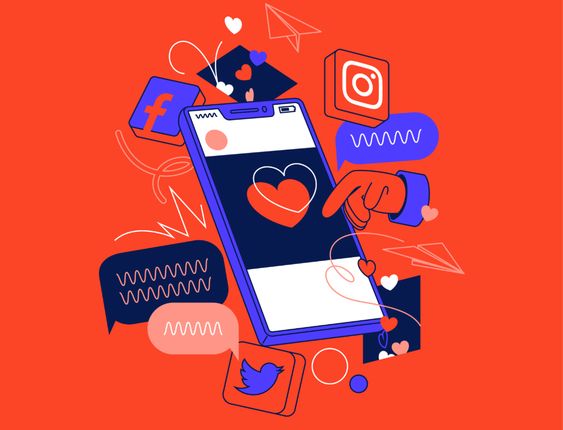ver the years we have seen technology progress in leaps and bounds. The social media evolution has been fuelled by the innate human impulse to communicate and form connections.
We now look at its effects both good and bad. With the ease of access that social media allows, it could be said that we are quite privileged to have this sea of information privy to us just at one click. We have an abundance of resources and access to other people’s lives so readily available without requiring any effort at all. This, however enticing as it may seem, how much can we really consume as media users? There has become this abundance of knowledge, opinions, and ever-changing news media jumping out as us on all social media platforms. We are nearly bombarded with waves of information, each day the topic changes and new information is added, new opinions are made. Has it or will it ever reach a point of excessiveness?
These two extremes we know are not be mutually exclusive. It is not one or the other but instead, the world of social media has its advantageous attributes but also comes with harsh impacts on society and the individual. Herein we will acknowledge the social media vs mental health grey area of overlapping. Where the good meets the bad. Studies have been done to show the positive and negative effects of social media on various elements of the individual and certain structures within our society. This will be an elaboration of those findings while assessing the topic of mental health within the framework of social media and how it can be helpful but also detrimental.

Social media has taken on multiple different types of platforms that display various genres of content.This content is delivered through multiple vehicles and contexts. From photos to videos, text, and various others. The content delivery is dependent on the purpose of the communication. To name a few of these platforms and their primary communication contexts; Facebook runs as the largest social media platform to date with the largest number of active users present on its interface. Thus, making Facebook a key platform for connecting people on various continents all over and a thriving environment for small to medium-sized businesses (Akram et al.,2017:345).
Twitter exists as a mainly text-based platform limited to 140 characters per post whereby the latest news, social thoughts and ideas are rapidly shared and retweeted amongst users within specific audience groups. YouTube is a video-sharing platform. It is one of the most educational platforms coming in second to being the most used search engine next to Google (Akram et al.,2017:345). Facebook-owned Instagram makes use of photo, video and text avenues for communication. It is a widely popular ‘glamorous’ platform where users post content from travel and lifestyle, health and wellness, business and craftsmanship, to personal blogs and a variety of other relatable content. Another platform coming under the Facebook conglomerate is WhatsApp Messenger. An instant messaging app with over 1billion active app participants.
These above-mentioned social media platforms are just to name a few of the many existing platforms therefore showing just how much we have access to as media users and just how these interfaces have been specially tailored to meet the needs of different types of users. The amount of content and knowledge available to us is unlimited as new information is being added with every passing second. With this continuous surge of content being brought to us, what sort of effects will this reproduce on the mental health of the individual?
A paper by Naslund and several other authors has considered the various links between social media and mental health. They have identified a few of its benefits and challenges. It is imperative to note that due to this growing topic of research that is ever-expanding as social media advances and health professionals become more knowledgeable about the topic of mental health; these discussions are based on research and ideas that are not yet a fully defined theory. Rather one that is continually developing and evolving.
The authors of this paper have identified three possible benefits that social media may have on an individual’s mental health. They have claimed these benefits to be aiding in the facilitation of social interaction; having access to peer support networks; promoting engagement and retention in services (Naslund et al., 2020). An individual with mental health challenges when engaging excessively on social media may suffer the following risks to their mental health. They may experience an increased impact on mental illness symptoms ,facing hostile interactions and consequences within their daily life (Naslundet al., 2020).
To touch on a few of the above-mentioned advantageous areas that social media creates when regarding mental health, if we are to consider individuals already facing mental health challenges. They may find difficulty with face-to-face interactions and thus an online setting may be the exact type of social interaction needed for this individual without the added stress of in-person contact (Naslund et al., 2020). Studies by other authors have shown the use of social media to form online relationships could decrease loneliness amongst those who may have challenges functioning socially (Brusilovskiy et al., 2016).
There are individuals who identify with mental health challenges where data on various platforms have been collected to show what these members have voiced. They claim that the community that has been formed around mental health allows for the flow of relevant content, personal and shared experiences and coping mechanisms. These arenas of communication is said to have helped these individuals feel less alone (Naslund et al., 2014).

PHOTO: COURTESY OF APPLE
With that being said, the use of social media to form online relationships has been shown to reduce the sense of loneliness in individuals who may have already existing mental health struggles like impaired social functioning because of mental illness. As we move along to the various risk factors that come alongside these benefits we will see an overlap, a grey area. A point where the benefits and risks intersect, and we see that the research that surrounds this topic is not as definitive.
There is room left open for debate and discussion as such theories and frameworks are still developing and even changing as new information becomes added by medical professionals and the experiences of those with mental health difficulties.There are consistencies highlighted in several studies concerning the use of social media and mental health. A correlation exists between the consistent and extended use of social media increasing the risk of an individual’s mental well-being and heightening symptoms surrounding mental illness (Andreassen et al., 2016; Kross et al., 2013; Woods and Scott, 2016). The symptoms that arise in these studies are increased anxiety, depressive states, and social comparison.
With such social peer pressure comes an increased sense of judgement later leading to social isolation (Stiglic and Viner, 2019; Rideout and Fox, 2018). This overlap of effects on the individual may show inconsistencies as in some it provides an increased sense of community deterring the feeling of isolation – where other sources of research show that the disconnect of face-to-face interactions may increase the sense of loneliness in someone overtime (Twenge and Campbell, 2018; Bucci et al., 2019). Not the stance of ambiguity and inconclusiveness in the research we were able to compile.
De Donker, a South African scholar from Cape Town did her study on The Impact of Social MediaTechnologies on Youth in Cape Town (2020). She had come to find an interesting link between the use of social media and a lack of sleep that has increased the presence of mental illness symptoms in these youth. It is recognized that the lack of sleep is induced by extended exposure to electronic and artificial lighting. A lack of sleep suppresses the production of melatonin in the brain (Wood et al., 2013:240).
This is not the only contributing factor but also increased anxiety and depressive symptoms due to the use of social media and the fear of being disconnected from the happenings, the ins and outs of the online world as confirmed by many other researchers as well (De Donker, 2020:59). SADAG (South African Depression and Anxiety Group) noted in an online news article three harmful effects driven by the frequent use of social media being; inadequate sleep and physical activity along with the exposure to cyberbullying which has other added effects on the individual’s self-esteem (Anon, 2019).
It is herein mentioned that despite some who may already have a genetic predisposition to developing such mental health challenges-others can “develop it as a result of loneliness and social isolation, bullying, loss, abuse and conflict” (Anon, 2019). The driver that would be initiating and bringing on such mental health effects to our local youth and the newer generation; the culprit they are contending with social media.
Social media and the online world as we have seen has some overlapping positive and negative effects on its active users. Research results are inconclusive in the sense of reproducing structured and definitive results for any sort of factual conclusions. We see research as only expanding the grey areas of this topic and filling in certain gaps within this theory.
This is because the number of variables assessed within these studies is just too extensive. Whereby the ‘vast-ness’ component of social media meets with the ‘vast-ness’ component of mental health whereby there are bound to be overlapping grey areas. However, there are consistencies within research that show there are both benefits contribute positively towards mental health and risk factors that are detrimental to one’s mental health. Both results co-exist and are not mutually exclusive.
References
Akram, W. and Kumar, R., 2017. A studyon positive and negative effects of social media on society. InternationalJournal of Computer Sciences and Engineering, 5(10), pp.351-354.
Andreassen, C.S., Billieux, J.,Griffiths, M.D., Kuss, D.J., Demetrovics, Z., Mazzoni, E. and Pallesen, S.,2016. The relationship between addictive use of social media and video gamesand symptoms of psychiatric disorders: A large-scale cross-sectional study. Psychologyof Addictive Behaviours, 30(2), p.252.
Anon, 2019. Teenage girls affected the most by socialmedia impact, warns mental health group. iol. Available at:https://www.iol.co.za/capetimes/arts-portal/lifestyle/teenage-girls-affected-the-most-by-social-media-impact-warns-mental-health-group-34044368[Accessed August 29, 2022].
Brusilovskiy, E., Townley, G., Snethen,G. and Salzer, M.S., 2016. Social media use, community participation andpsychological well-being among individuals with serious mental illnesses. Computersin Human Behaviour, 65, pp.232-240.
Bucci, S., Schwannauer, M. and Berry,N., 2019. The digital revolution and its impact on mental health care. Psychologyand Psychotherapy: Theory, Research and Practice, 92(2), pp.277-297.
Kross, E., Verduyn, P., Demiralp, E.,Park, J., Lee, D.S., Lin, N., Shablack, H., Jonides, J. and Ybarra, O., 2013.Facebook use predicts declines in subjective well-being in young adults. PloSone, 8(8), p.e69841.
Naslund, J.A., Bondre, A., Torous, J.and Aschbrenner, K.A., 2020. Social media and mental health: benefits, risks,and opportunities for research and practice. Journal of technology inbehavioural science, 5(3), pp.245-257.
Naslund, J.A., Grande, S.W.,Aschbrenner, K.A. and Elwyn, G., 2014. Naturally occurring peer support throughsocial media: the experiences of individuals with severe mental illness usingYouTube. PLOS one, 9(10), p.e110171.
Rideout, V. and Fox, S., 2018. Digitalhealth practices, social media use, and mental well-being among teens and youngadults in the US.
Stiglic, N. and Viner, R.M., 2019.Effects of screen time on the health and well-being of children andadolescents: a systematic review of reviews. BMJ open, 9(1),p.e023191.
Twenge, J.M. and Campbell, W.K., 2018.Associations between screen time and lower psychological well-being amongchildren and adolescents: Evidence from a population-based study. Preventivemedicine reports, 12, pp.271-283.
Wood, B., Rea, M.S., Plitnick, B., and Figueiro, M.G.2013. Light Level and Duration of Exposure Determine the Impact ofSelf-luminous Tablets on Melatonin Suppression. Journal of Applied Ergonomics,44(2): 237-240.
Woods, H.C. and Scott, H., 2016. #Sleepyteens: Social media use in adolescence is associated with poor sleepquality, anxiety, depression and low self-esteem. Journal of adolescence,51, pp.41-49.